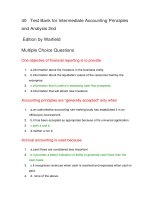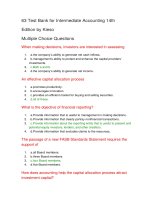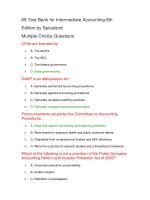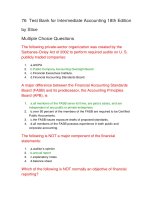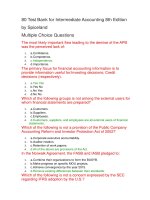102 bank for intermediate accounting 2nd
Bạn đang xem bản rút gọn của tài liệu. Xem và tải ngay bản đầy đủ của tài liệu tại đây (118.28 KB, 24 trang )
102 Bank for Intermediate Accounting 2nd
rue-False Questions
The primary responsibility for properly applying GAAP when
communicating with investors and creditors through
financial statements lies with a firm's auditors.
1.
True
2.
False
Equity is a residual amount representing the owner's interest in
the assets of the business.
1.
True
2.
False
Materiality can be affected by the dollar amount of an item, the
nature of the item, or both.
1.
True
2.
False
Trade offs are often required between relevance and reliability.
1.
True
2.
False
Capital markets provide a mechanism to help the economy
allocate resources.
1.
True
2.
False
Comprehensive income is another term for net income.
1.
True
2.
False
Conservatism is a desired qualitative characteristic of
accounting information.
1.
True
2.
False
The primary function of financial accounting is to provide
relevant financial information to parties external to
business enterprises.
1.
True
2.
False
Revenues are inflows or other enhancements of assets or
settlements of liabilities from activities that constitute the
entity's ongoing operations.
1.
True
2.
False
Auditors play an important role in the resource allocation
process by adding credibility to financial statements.
1.
True
2.
False
Accrual accounting attempts to measure revenues and
expenses that occurred during accounting periods so
they equal net operating cash flow.
1.
True
2.
False
A rules-based approach to standard setting stresses
professional judgment as opposed to following a list of
rules.
1.
True
2.
False
The FASB is currently the public sector organization
responsible for setting accounting standards in Canada.
1.
True
2.
False
Accounting choices should influence the behavior of
managers.
1.
True
2.
False
Gains or losses result, respectively, from the disposition of
business assets for greater than, or less than, their book
values.
1.
True
2.
False
The Canadian legislation and securities regulations require
companies listed on Canadian stock exchanges to
prepare statements that conform to GAAP
1.
True
2.
False
Multiple Choice Questions-Page 1
The AcSB consists of a maximum of ___________members
1.
A. 5
2.
B. 12
3.
C. 15
4.
D. 9
Which of the following groups is not among financial
intermediaries?
1.
A. Mutual fund managers
2.
B. Financial analysts
3.
C. CICA
4.
D. Credit rating organizations
A sole proprietor of a convenience store has included his home
on the balance sheet of his business. This violates:
1.
A. Monetary unit assumption
2.
B. Going Concern Principle.
3.
C. Periodicity assumption.
4.
D. Economic entity assumption
The process of identifying, measuring, analyzing and
communicating financial information to plan, evaluate and
control operations is
1.
A. Financial Accounting.
2.
B. Auditing
3.
C. Tax accounting.
4.
D. Management Accounting.
A tradeoff is often required between various degrees of:
1.
A. Matching and Materiality.
2.
B. Timeliness and Neutrality.
3.
C. Consistency and Comparability
4.
D. Relevance and Reliability.
When a company charges the entire cost of a small appliance to
expense in the year of purchase even though it has an
estimated useful life of 3 years, this is an application of:
1.
A. Matching principle.
2.
B. Historical cost principle.
3.
C. Materiality constraint.
4.
D. full disclosure principle.
Which of the following is not considered a qualitative
characteristic under the Conceptual Framework?
1.
A. Relevance
2.
B. Understandability.
3.
C. Fair value.
4.
D. Consistency
The conceptual framework's qualitative characteristic of
relevance includes:
1.
A. Timeliness.
2.
B. Verifiability.
3.
C. Representational faithfulness.
4.
D. Neutrality.
Corporations provide shareholders quarterly and annual
statements. This is an example of:
1.
A. Going Concern
2.
B. Monetary Unit.
3.
C. Periodicity
4.
D. Relevance
Which of the following groups is not among the external users
for whom financial statements are prepared?
1.
A. Customers
2.
B. Suppliers
3.
C. Employees
4.
D. All of these are external users of financial statements.
A firm's comprehensive income is always:
1.
A. The same as its net income.
2.
B. Greater than its net income.
3.
C. Less than its net income.
4.
D. Could be greater than or less than net income.
The full disclosure principle requires a balance between:
1.
A. Comparability and consistency.
2.
B. Relevance and cost effectiveness.
3.
C. Reliability and neutrality.
4.
D. Timeliness and predictive value.
External decision makers would not look primarily to financial
accounting information to assist them in making
decisions on:
1.
A. Granting credit.
2.
B. Capital budgeting.
3.
C. Selecting stocks.
4.
D. Mergers and acquisitions.
In order to coordinate the provincial securities commissions,
the Canadian Securities Administrators was formed and
make all filings of Canadian listed companies available
through:
1.
A. SEDAR
2.
B. EDGAR.
3.
C. AcSB
4.
D. IASB.
Which of the following is not true about net operating cash
flow?
1.
A. It is the difference between cash receipts and cash disbursements from providing
goods and services.
2.
B. It is a measure used in accrual accounting and is recognized as the best predictor of
future operating cash flows.
3.
C. Over short periods of time, it may not be indicative of long-run cash-generating
ability.
4.
D. It is easy to understand and all information required to measure it is factual.
ABC Company charges all of their capital expenditures under
$500 to expense. What principle is this policy based on?
1.
A. Matching.
2.
B. Materiality.
3.
C. Full Disclosure
4.
D. Comparability.
Which of the following does not apply to secondary markets?
1.
A. Transactions are important to the efficient allocation of resources in our economy.
2.
B. New resources are provided when shares of a company are sold by the corporation
to the initial owners.
3.
C. Transactions help to establish market prices for additional shares that may be
issued in the future.
4.
D. Many investors might be unwilling to provide resources to corporations if there is no
available mechanism for the future sale of their stocks and bonds to others.
A cause-and-effect relationship is implicit in the:
1.
A. Realization principle.
2.
B. Historical cost principle.
3.
C. Matching principle.
4.
D. Going concern assumption.
Which of the following is not a secondary source of GAAP
1.
A. FASB
2.
B. IASB
3.
C. EIC Abstracts
4.
D. Approved exposure drafts.
In a recent annual report, Apple Computer reported the
following in one of its disclosure notes: "Warranty
Expense: The Company provides currently for the
estimated cost for product warranties at the time the
related revenue is recognized." This note exemplifies
Apple's use of:
1.
A. Conservatism
2.
B. The matching principle
3.
C. Realization principle
4.
D. Full disclosure principle
Accounting standard setting has been characterized as:
1.
A. A political process.
2.
B. Using the scientific method.
3.
C. Pure deductive reasoning.
4.
D. Pure inductive reasoning.
The International Accounting Standards Board:
1.
A. Was the predecessor to the IASC.
2.
B. Can overrule the FASB when their policies disagree.
3.
C. Promotes the use of high-quality, understandable global accounting standards.
4.
D. Has its headquarters in Geneva.
Which of the following is responsible for setting accounting
standards in Canada?
1.
A. IASB
2.
B. AcSB
3.
C. FASB
4.
D. AICPA
The AcSB's conceptual framework's qualitative characteristics
of accounting information include:
1.
A. Full disclosure.
2.
B. Relevance.
3.
C. Going concern.
4.
D. Historical cost.
The recognition of which of the following expenses exemplifies
the application of the matching principle?
1.
A. President's salary.
2.
B. Research and development.
3.
C. Cost of goods sold.
4.
D. Advertising.
Which of the following is not a primary source of GAAP
1.
A. FASB pronouncements
2.
B. CICA handbook
3.
C. AcSB interpretation guides.
4.
D. EIC abstracts.
The AcSB's conceptual framework's qualitative characteristics
of accounting information include:
1.
A. Historical cost.
2.
B. Realization.
3.
C. Reliability.
4.
D. Full disclosure.
Which of the following has the authority to set accounting
standards in the United States?
1.
A. FASB
2.
B. IRS
3.
C. SEC
4.
D. AICPA
The Security commissions in Canada are responsible for
1.
A. Accounting Standards.
2.
B. Overseeing capital market exchanges.
3.
C. Banking regulations.
4.
D. Setting interest rates.
GAAP is an abbreviation for:
1.
A. Generally authorized accounting procedures.
2.
B. Generally applied accounting procedures.
3.
C. Generally accepted auditing practices.
4.
D. Generally accepted accounting principles.
Identify the traits that make financial information useful:
1.
A. Comparability and Consistency.
2.
B. Reliability and relevance
3.
C. Understandability.
4.
D. All of the above.
71 Free Test Bank for Intermediate Accounting 2nd
Canadian Edition by Spiceland Multiple Choice
Questions-Page 2
When there is agreement between a measure or description and
the phenomenon it purports to represent, information
possesses which characteristic?
1.
A. Verifiability.
2.
B. Predictive value.
3.
C. Representational faithfulness.
4.
D. Timeliness.
The best argument in support of historical cost information is:
1.
A. Relevance.
2.
B. Predictive quality for future cash flows.
3.
C. Materiality.
4.
D. Verifiability.
The conceptual framework's recognition and measurement
concepts recognize which of the following as an
assumption, rather than a principle?
1.
A. Going concern.
2.
B. Historical cost.
3.
C. Full disclosure.
4.
D. Realization.
Elements of financial statements do not include:
1.
A. Monetary unit.
2.
B. Investments by owners.
3.
C. Comprehensive income.
4.
D. Losses.
Financial reporting objectives do not include providing
information:
1.
A. About resources, obligations, and changes.
2.
B. To determine market values, assess profit potential, and evaluate management.
3.
C. To assess the amounts and timing of prospective cash receipts.
4.
D. To make rational investment, credit, and similar decisions.
Surefeet Corporation changed its inventory valuation method.
Which characteristic is jeopardized by this change?
1.
A. Comparability.
2.
B. Representational faithfulness.
3.
C. Consistency.
4.
D. Feedback value.
To meet the needs of full disclosure, companies use
supplemental information, including:
1.
A. Parenthetical comments or modifying comments placed on the face of the financial
statements.
2.
B. Disclosure notes conveying additional insights about company operations,
accounting principles, contractual agreements, and pending litigation.
3.
C. Supplemental financial statements that report more detailed information than is
shown in the primary financial statements.
4.
D. All of these are correct.
The assumption that in the absence of contrary information a
business entity will continue indefinitely is the:
1.
A. Periodicity assumption.
2.
B. Entity assumption.
3.
C. Going concern assumption.
4.
D. Historical cost assumption.
Constraints on qualitative characteristics of accounting
information include:
1.
A. Timeliness.
2.
B. Going concern.
3.
C. Neutrality.
4.
D. Materiality.
One of the elements that many believe distinguishes a
profession from other occupations is the acceptance by
its members of a responsibility for the interests of those it
serves, often articulated in:
1.
A. Its conceptual framework.
2.
B. Its code of ethics.
3.
C. Federal laws.
4.
D. State laws.
Maltec Corporation has started placing its quarterly financial
statements on its web page, thereby reducing by ten days
the time to get information to investors and creditors. The
qualitative concept improved is:
1.
A. Comparability.
2.
B. Consistency.
3.
C. Relevance.
4.
D. Reliability.
Primary qualitative characteristics of accounting information
are:
1.
A. Relevance and comparability.
2.
B. Comparability and consistency.
3.
C. Reliability and relevance.
4.
D. Reliability and consistency.
Net income equals:
1.
A. Assets minus liabilities.
2.
B. Revenues minus cost of goods sold.
3.
C. Revenues minus expenses.
4.
D. Cash receipts minus cash payments.
If an independent auditing firm is satisfied that statements are
presented fairly in accordance with GAAP, they will
express which of the following:
1.
A. A clean opinion
2.
B. An unqualified opinion.
3.
C. A disqualified opinion.
4.
D. A rejection of opinion.
Change in equity from nonowner sources is:
1.
A. Comprehensive income.
2.
B. Revenues.
3.
C. Expenses.
4.
D. Gains and losses.
Of the following, the most important objective for financial
reporting is to provide information useful for:
1.
A. Predicting cash flows.
2.
B. Determining taxable income.
3.
C. Providing accountability.
4.
D. Increasing future profits.
The main issue in the debate over accounting for employee
stock options was:
1.
A. Which employees should receive options.
2.
B. The amount of compensation expense that a company should recognize.
3.
C. How many options should be granted to key executives.
4.
D. The tax consequences of employee stock options.
Primecoat could get its annual financial statements two days
earlier if it shifted substantial human resources from
other operations to the annual report project.
Management decided the value of the earlier report was
not worth the added commitment of resources. The
concept demonstrated is:
1.
A. Timeliness.
2.
B. Materiality.
3.
C. Relevance.
4.
D. Cost effectiveness.
The conceptual framework of accounting should have many
positive effects as new accounting standards are
developed. Which of the following is not one of those
effects?
1.
A. Financial statements among companies should be more consistent and comparable
2.
B. Standard setting should be more consistent with the objectives of financial reporting
3.
C. Management should have greater latitude in choosing among accounting
alternatives
4.
D. Users' understanding in financial statements should increase
According to the conceptual framework, verifiability implies:
1.
A. Legal evidence.
2.
B. Logic.
3.
C. Consensus.
4.
D. Legal verdict.
Land was acquired in 2009 for a future building site at a cost of
$40,000. The assessed valuation for tax purposes is
$27,000, a qualified appraiser placed its value at $48,000,
and a recent firm offer for the land was for a cash
payment of $46,000. The land should be reported in the
financial statements at:
1.
A. $40,000.
2.
B. $27,000.
3.
C. $46,000.
4.
D. $48,000.
Financial accounting information should provide information
about:
1.
A. Resources of an enterprise.
2.
B. Claims to resources.
3.
C. The effects of transactions that cause changes in resources.
4.
D. All of these.
Which of the following Sections of the CICA handbook defines
the 8 elements of financial statements?
1.
A. CICA 1000
2.
B. CICA 1300, 3855
3.
C. CICA 1000, 3855
4.
D. CICA 1000, 1530
The possibility that the capital markets' focus on periodic
profits may tempt a company's management to bend or
even break accounting rules to inflate reported net
income is an example of:
1.
A. An ethical dilemma.
2.
B. An accounting theory issue.
3.
C. A technical accounting issue.
4.
D. None of these is correct.
For Financial statements to be relevant, they should possess:
1.
A. Representational faithfulness.
2.
B. Verifiability.
3.
C. Predictive value
4.
D. Neutrality.
Recognizing expected losses immediately, but deferring
expected gains, is an example of:
1.
A. Materiality.
2.
B. Conservatism.
3.
C. Cost effectiveness.
4.
D. Timeliness.
Financial reporting objectives state that financial statements
should be comprehensible to:
1.
A. Accounting experts.
2.
B. Those who have a reasonable understanding of business and economic activities
and are willing to study the information.
3.
C. Large investors.
4.
D. The average investor with average communication skills and average training and
experience.
Gains are:
1.
A. Inflows from selling a product or service to a customer.
2.
B. Increases in equity resulting from transfers of assets to the company from owners.
3.
C. Increases in equity from peripheral transactions of an entity.
4.
D. None of these.
Mega Loan Company has very stringent credit requirements
and, accordingly, has negligible losses from uncollectible
accounts. The company's independent accountants did
not protest when, contrary to GAAP, the company
recorded bad debt expense only when specific accounts
were determined to be uncollectible, rather than use an
allowance for uncollectible accounts. The concept
demonstrated is:
1.
A. Comparability.
2.
B. Representational faithfulness.
3.
C. Cost effectiveness.
4.
D. Materiality.
The matching principle is:
1.
A. A valuation method.
2.
B. An expense recognition accounting principle.
3.
C. A cash basis reporting principle.
4.
D. An asset classification procedure.
The conceptual framework's recognition and measurement
concepts recognize which of the following as a principle,
rather than an assumption?
1.
A. Periodicity.
2.
B. Monetary unit.
3.
C. Conservatism.
4.
D. Full disclosure.
Secondary qualitative characteristics of accounting information
include:
1.
A. Relevance and comparability.
2.
B. Comparability and consistency.
3.
C. Reliability and relevance.
4.
D. Reliability and consistency.
To provide information useful to the decision maker,
supplementary information could be in the form of:
1.
A. Comments on face of statements.
2.
B. Disclosure notes.
3.
C. Additional detailed statements.
4.
D. All of the above.
The conceptual framework's qualitative characteristic of
reliability includes:
1.
A. Predictive value.
2.
B. Neutrality.
3.
C. Feedback value.
4.
D. Timeliness.
Disclosure notes to a company's financial statements:
1.
A. Are relatively unimportant facts that don't belong in the basic financial statements.
2.
B. Document the source of financial statement facts, like literary footnotes.
3.
C. Are an integral part of a company's financial statements.
4.
D. Are irrelevant facts that are immaterial in amount.
Revenue should not be recognized until:
1.
A. The earnings process is complete and collection is reasonably assured.
2.
B. Contracts have been signed and payment has been received.
3.
C. Work has been performed and customer has been billed.
4.
D. Collection has been made and warrantees have expired.
Four different competent accountants independently agree on
the amount and method of reporting an economic event.
The concept demonstrated is:
1.
A. Reliability.
2.
B. Comparability.
3.
C. Representational faithfulness.
4.
D. Verifiability.
Which of the following best demonstrates the full disclosure
principle:
1.
A. The multi-step income statement.
2.
B. The auditors' report.
3.
C. The company's tax return.
4.
D. Disclosure notes to financial statements.
Independent auditors express an opinion on the:
1.
A. Fairness of financial statements.
2.
B. Accuracy of financial statements.
3.
C. Soundness of a company's future.
4.
D. Quality of a company's management.
If a company has gone bankrupt, its financial statements likely
violate:
1.
A. The matching principle.
2.
B. The realization principle.
3.
C. The stable monetary unit assumption.
4.
D. The going concern assumption.
Free Text Questions
Accounting standards have developed over time to reflect
changes in the business world as well as changes in our
ability to account for such changes. Using the example of
marking assets and liabilities to their fair value, explain
why you would expect accounting standards to change.
Answer Given
Historically, financial accounting relied on transaction amounts (historical cost) as the
fundamental measurement approach for reporting assets and liabilities. As markets
have matured, it is more relevant and feasible to report some assets and liabilities at
their fair values, particularly if such items have a ready market that is active.
Compared to financial accounting, what are the major concerns
of managerial accounting?
Answer Given
Management accounting is concerned with preparing and analyzing information for the
exclusive use of management for decision-making, planning, employee motivation,
and internal performance evaluation. The level of detail is much greater and the basis
of accountability may differ from that presented in the organization's financial
statement.
Discuss in general the due process procedure the AcSB follows
in developing accounting standards. Who are the groups
which typically have opposing views when it comes to
accounting standards, and why?
Answer Given
After identifying an issue of interest, the AcSB writes a project proposal which defines
the terms of reference, the need and scope of the issue, and those affected. A task
force is made up to monitor the issue to its conclusion. An issues paper may be
prepared to help the AcSB members to appreciate the problems. A statement of
principles is usually prepared to outline the basic response to the issues raised. Input
is then sought on a private and confidential basis to fine-tune the issues. After AcSB
approval, an exposure draft is developed and circulated to all interested parties and
input is requested. Revisions may result in a re-exposure draft being circulated again
for further public input. The two groups with frequently opposing views are the
preparers (reporting companies) and the investment community. Reporting companies
base their arguments for or against a standard on how their interests might be affected
by a new standard. The investment community typically wants expanded disclosure to
enable the best possible decisions concerning resource allocation, and favours neutral
reporting. The AcSB prefers neutral financial accounting principles to principles which
would have a goal of influencing particular types of economic activity or government
regulation.
What is meant by the term GAAP ?
Answer Given
GAAP (Generally Accepted Accounting Principles) used to facilitate comparisons of
financial information so investors can make resource allocation decisions. GAAP are a
dynamic set of both broad and specific guidelines that companies should follow when
measuring and reporting information in their financial statements and disclosure notes
How does the value of an audit affect financial statements?
Answer Given
Outside auditors add credibility to financial statements, increasing the confidence of
capital market participants who rely on financial statements in making investment and
credit decisions and recommendations.
Accounting standard setting has been characterized as a
political process. Discuss this proposition giving an
example.
Answer Given
Changes in standards can have significant differential effects on companies, investors,
creditors, and other interest groups. AcSB must gauge the economic consequences of
a change in accounting standards. The process by which financial accounting
standards are created includes public comment and sometimes hearings. Ultimately, a
vote must be taken to pass a standard. Accounting for stock-based compensations
(options) and post-retirement health care benefits are examples where accounting
practices have been affected by political influences on
Briefly describe the Benefit versus cost constraint.
Answer Given
Information should be provided only if the perceived benefit of increased decision
usefulness (which should improve the resource allocation process) will exceed the
anticipated costs of providing that information. An example is disaggregated
information companies argued that disclosing this information could lead to a
competitive disadvantage. Costs are higher than benefits of including data.
Explain and show an example of how the AcSB's conceptual
framework is needed in formulating standards on
controversial topics.
Answer Given
There are many possible examples here. For example, in debating accounting for
stock-based compensation, the AcSB's conceptual framework explains the rationale
for treating stock options as an expense. By relating the accounting for such
compensation to the purpose of financial statements and their qualitative
characteristics, the AcSB can defend its positions without the bias inherent in such
controversial issues
Identify or define the following terms: a. historical cost, b.
realization.
Answer Given
Historical cost - Asset and liability measurements should be based on the amount
given or received in an exchange transaction. Realization - Revenue should be
recognized only after the earnings process is virtually complete and there is
reasonable certainty of collecting the asset to be received from the customer.
Identify or define the following terms: a. periodicity, b. monetary
unit.
Answer Given
Periodicity - The life of a company can be divided into artificial time periods to provide
timely information to external users. Monetary unit - In the U.S., financial statement
elements should be measured in terms of the U.S. dollar. It assumes that the value of
a dollar is stable over time.
List the four financial statements most frequently provided to
external users.
Answer Given
Balance sheet, Income statement, Cash flow Statement, Statement of Retained
earnings
Compare the 2006 net income (loss) for Amazon.com to its net
cash flow from operating activities. Why are these
amounts different? Briefly explain.
Answer Given
These amounts are different because of the differences between cash and accrual
accounting. As opposed to cash flows from operations, net income includes both
revenues and expenses the timing of which differs from the timing of certain cash
receipts and payments. Examples would be credit sales in which the revenues are
recorded before the collection of cash and cost of goods sold in which the expense
often is recorded later than the cash payment to the supplier for the merchandise.
Give an example of a violation of the stable monetary unit
assumption. How would it affect the quality of financial
statement information?
Answer Given
In a place or time in which a country experiences severe inflation, this would violate
the assumption that dollar amounts are constantly valued. This would limit the
usefulness of adding numbers in financial statements, because (for instance) costs at
different times are not comparable without adjusting for changes in purchasing power.
Identify or define the following terms: a. economic entity, b.
going concern.
Answer Given
Economic entity - All economic events can be identified with a particular economic
entity. Going concern - In the absence of information to the contrary, it is anticipated
that a business entity will continue to operate indefinitely.
What is the EIC and what is its purpose?
Answer Given
The Emerging Issues Committee (EIC) is a group set up by the AcSB. Its main focus is
to identify financial reporting issues and attempt to resolve them without involving the
AcSB. The goal is to provide a timely response to emerging financial reporting issues.
Briefly describe the materiality constraint.
Answer Given
Materiality - Information is material if it can have an effect on a decision made by a
user. If an item is not material, GAAP need not be followed. For example, if a large
corporation purchased a water cooler for one of its common areas for $120, the
amount could be expensed rather than recorded as an asset even though the cooler
will be useful for several years. Materiality is a judgment call. Materiality is concerned
with both the dollar amount of an item and/or the nature of an item. It would probably
be material if Microsoft received $1,000,000 in bribes from the Chinese for its
technology. A $1,000,000 write-off of old equipment would probably be immaterial for
Microsoft. Students examples will vary.

